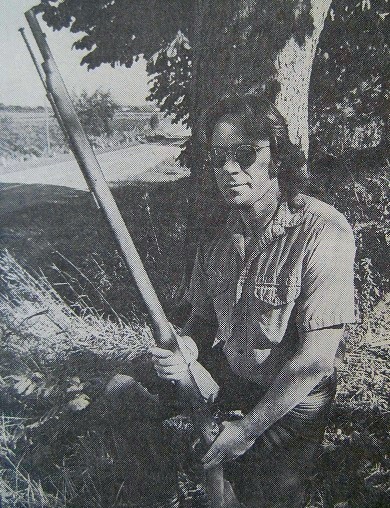Plaque Will Honor Little-known Black Unit in War of 1812
By Debra Ann Yeo
[St. Catharines Standard, 1992]
 Staff Photograph by Mark Conley
Staff Photograph by Mark Conley
They had no obligation to fight in the War of 1812.
Most were former slaves, and few owned land-the criterion for compulsory military service.
Some of their race were still enslaved in Niagara despite a clause in the Upper Canada Act that legislated partial emancipation.
They were: ”Robert Runchey’s corps of colored men ”believed to be the first black unit in Canadian military history.
Only 25 to 50 men strong, they fought at the battles of Queenston Heights and Stoney Creek and against the American siege of Fort George in 1812-1813.
Their contributions to the history of Niagara and Ontario are to be honored with a historical plaque.
The proposed location is Regional Road 81 ( Old Highway 8 ) more than a kilometre east of Jordan-where Runchey’s home, inn and stage-coach stop once stood.
Paul Litt, a historical consultant with the Ontario Heritage Foundation, said Runchey’s men were the only all-Black corps to fight in the War of 1812.
“It shows there was a distinct black community in that area of Ontario at that time, much easier than most people thought. “
“They had enough interest in the British cause to organize to help them in the war,” said Litt.
Jon Jouppien, a member of the committee that proposed the plaque in 1987, said the volunteer soldiers’ contribution to history “sort of fell through the floorboards of time.”
“You would never know they existed,” agreed Al Holden, chairman of the Niagara Heritage Commemorative Committee and an unpublished author of Niagara military history.
Yet, Holden said, the soldiers served “with distinction” at Queenston Heights, part of the first advance against the Americans.
It was Richard Pierpoint, a former slave who was one of the first few black landholders in Niagara and one of the first settlers in what is now St. Catharines, who organized the company.
Since there were no black army officers, Pierpoint, a private, wasn’t allowed to lead the corps. It was Runchey, a white man and member of the first Lincoln Militia, who was given command.
Even though he led the company less than a year, they were known throughout the war as “Runchey’s company of colored men.”
Most had escaped slavery in the U.S. Some had served with Butler’s Rangers during the American Revolution.
Most resided in Niagara, although some came from York (Toronto) where they had joined the militia.
Holden tells a tale of one slave named Jack who fled his Grimsby masters to join the company. He was turned away when his owner came to claim him.
Despite the Upper Canada Act, slavery was not officially abolished in Canada until 1834 when it was banned throughout the British Empire.
Runchey’s men were headquartered in Niagara-on-the Lake during the war but segregated from the white troops.
By 1814-the year they finally got uniforms of black gaiters, green jackets with yellow facings and felt caps with plumes-they had become artificers, excavating earthworks and doing other engineering jobs around Fort George.
Records obtained by Holden from the national archives show 14 of Runchey’s men were dead by 1820, at least 10 were still in Niagara, seven deserted during the war and at least two died in battle.
Volunteers who had kept their posts and lived were granted land for their service.
By 1819, Runchey was also dead. His house stood until the early 1970s’ when it was demolished after a fire.
Although the committee hoped to erect the plaque to coincide with Jordan’s Pioneer Day, Litt said, it’s too late to make the Oct. 17 date.
A second provincial plaque honoring Harriet Tubman will be erected in St. Catharines in February 1993, which is black history month.
Tubman was an escaped American slave who lived in St. Catharines from 1851 to 1858, according to the St. Catharines Museum.
Nicknamed Moses, she made many dangerous trips back to the U.S., guiding a least 300 slaves to freedom in Canada along the famous Underground Railroad.
The home she rented on North Street, which is no longer standing, was used as a boarding house for the escaped slaves.
 Subscribe..
Subscribe..
Add A Comment
You must be logged in to post a comment.